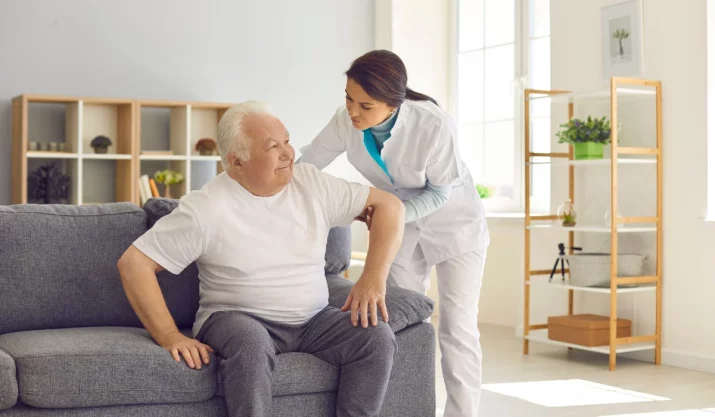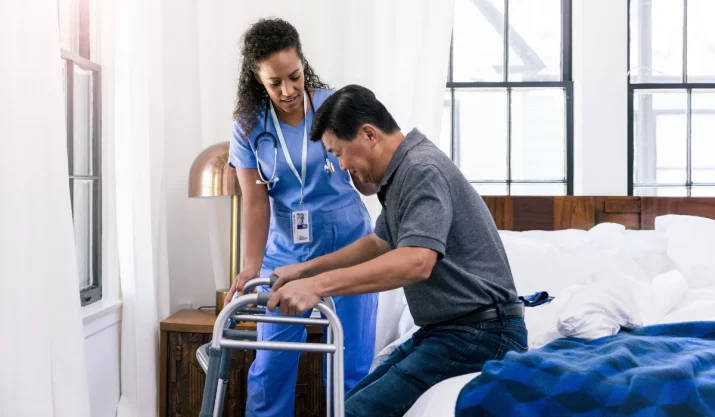How to Use a Cane After Hip Replacement Surgery

Table of Contents
- Key Takeaways
- 1. Choose the Right Cane for Support
- 2. Adjust the Cane to the Correct Height
- 3. Hold the Cane in the Correct Hand
- 4. Learn How to Walk with a Cane
- 5. Transition from a Walker to a Cane
- 6. Stand Up and Sitting Down with a Cane
- 7. Go Up and Down Stairs with a Cane
- 8. Follow Hip Precautions to Protect Your New Hip
- 9. Monitor Your Progress and Reduce Cane Use
- 10. When to Seek Medical Advice
- Stay Safe and Independent with the Right Support
Recovering from hip replacement surgery takes time, patience, and proper support. Whether you’ve had a total hip replacement or another type of joint replacement surgery, learning to use a walking cane correctly is key to regaining mobility.
A cane correctly used will improve weight bearing on your operated leg, help with balance, and allow you to return to daily activities safely. In this guide, we’ll walk you through the process of transitioning from a walker to a cane, ensuring that you move with confidence while protecting your new hip.
Key Takeaways
- Using the right cane and adjusting it to the correct height helps you stay stable and comfortable while walking.
- Holding the cane in the opposite hand and using the correct walking technique helps take pressure off your hip.
- Standing, sitting, and going up and down stairs safely with a cane helps you avoid falls and stay steady.
- Watching your progress, following hip precautions, and knowing when to get medical help will keep your recovery on track.
1. Choose the Right Cane for Support
Using the right walking aid can make a big difference in your postoperative recovery. Each type offers different levels of support, so choosing the best fit is important.
Here’s a look at your options:
| Types of Cane | Description |
|---|---|
| Standard Cane | Best for those with minimal balance issues. |
| Offset Cane | Helps distribute weight and reduce hip pain. |
| Quad Cane | Provides extra stability with a wider base. |
Your physical therapist or orthopedic specialist can recommend the best assistive device based on your needs.
2. Adjust the Cane to the Correct Height
A cane that’s too high or too low can throw off your balance and make walking uncomfortable.
To find the right height, stand naturally with your arms relaxed at your sides. The top of the cane should be level with the crease of your wrist. When you hold it, your elbow should bend slightly—about 15 to 20 degrees.
If the cane doesn’t feel right or causes strain, your healthcare provider or physical therapist can help adjust it for a better fit.
3. Hold the Cane in the Correct Hand
It might seem natural to hold the cane on the same side as your operated leg, but that’s actually incorrect. To walk safely and maintain proper balance, you should hold the cane in the hand opposite your operated leg.
For example, if you had a right hip replacement, keep the cane in your left hand.
This technique helps shift weight bearing away from your hip joint, reducing strain and making each step feel more stable.
4. Learn How to Walk with a Cane
Once you have the right cane and position, start by moving it forward about one step’s length.
Step forward with your operated leg, using the cane for support, then bring your good leg past it in a smooth motion. Take small steps and keep a steady pace to maintain balance.
Practicing this technique in physical therapy will help you feel more confident as you regain mobility with a cane.
5. Transition from a Walker to a Cane
Switching from a walker to a cane should be done gradually.
You’re ready when you can walk without your crutches, your physical therapist approves, and you feel stable standing up without holding onto anything.
To transition, stand using your walker, grab your walking cane in the correct hand, and take small steps, shifting your weight bearing onto the cane as needed.
Move steadily to keep your new hip safe.
6. Stand Up and Sitting Down with a Cane
Many falls happen when standing up or sitting down, so move carefully.
To stand, sit near the edge of the chair with your cane in hand. Push up using your good leg and the armrests, not the cane.
Once upright, steady yourself before walking.
To sit down, back up to the chair until it touches your legs. Hold a handrail or armrest for support, then lower yourself slowly, keeping your operated leg slightly extended to avoid bending your hip joint too much.
7. Go Up and Down Stairs with a Cane
Going up and down stairs after hip replacement surgery can feel intimidating, but using the handrail and the right technique will help prevent falls.
When going up, step first with your good leg, then bring your operated leg and cane up to the same step. Keep this pattern going until you reach the top.
When heading down stairs, do the opposite—place your cane and operated leg down first, then follow with your good leg. Take it slow, making sure your walking aid is secure before each step.
An easy way to remember the right order is: “Up with the good, down with the bad.“
8. Follow Hip Precautions to Protect Your New Hip
To keep your new hip safe, follow your doctor’s hip precautions. Avoid bending your hip joint past 90 degrees, as too much flexion can put stress on the operated leg.
Don’t cross your legs at the knees or ankles, as this can lead to instability. Always keep your toes pointed forward when walking to maintain proper alignment.
If you need to pick something up, use a reacher instead of bending over.
9. Monitor Your Progress and Reduce Cane Use
As your range of motion improves, you may need your cane less often. Signs that you can safely move forward without it include:
- You can walk without hip pain.
- Your physical therapist approves discontinuing the cane.
- You no longer rely on the cane for balance.
Even if you feel good, don’t rush—recovery takes time.
10. When to Seek Medical Advice
If you experience severe hip pain, increased swelling or redness in your operated leg, or difficulty with weight bearing, contact your healthcare provider. A fall, near-fall, or sudden instability are also signs you need medical attention.
Your orthopedic doctor or physical therapist can adjust your recovery plan to keep you on track.
Stay Safe and Independent with the Right Support
Using a walking cane correctly after hip replacement surgery is an important step in regaining mobility and independence. If you’re ever unsure about your progress, check in with your healthcare provider.
At California Mobility, we know how important it is to feel safe and confident at home. That’s why we offer assistive devices like stair lifts, ramps, and home elevators to make everyday movement easier. If you need extra support getting around, contact us today.








